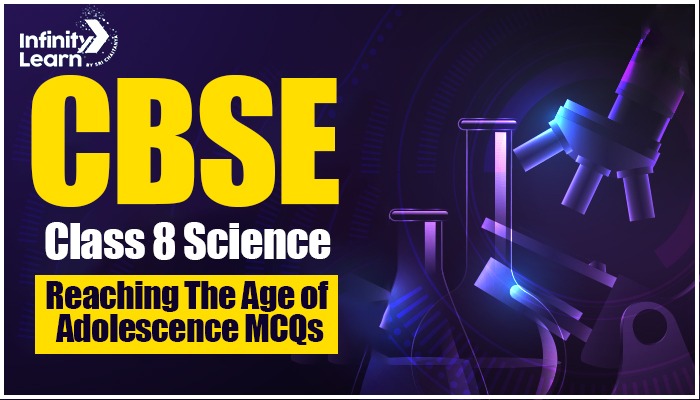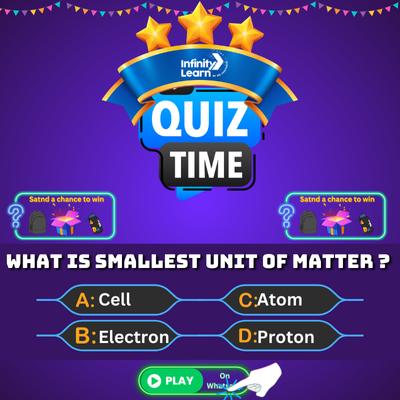Reaching The Age of Adolescence MCQs: Looking to strengthen your preparation for Class 8 Science Chapter – Reaching The Age of Adolescence? Our expertly designed MCQs for Class 8 Science strictly follow the latest CBSE (2024–2025) syllabus and NCERT guidelines, helping you stay ahead in your exam prep. These multiple-choice questions are carefully curated to match the current CBSE exam pattern, giving you the confidence to tackle real exam questions with ease.
Whether you’re brushing up on key concepts or testing your understanding of hormones, puberty, and adolescence, these Class 8 MCQs will help boost your concept clarity and problem-solving skills. We’ve also included clear explanations for selected questions to help you learn the logic behind each answer and grasp difficult concepts better.

Key Features of Class 8 Science MCQs on Reaching The Age of Adolescence:
- Based on the latest CBSE 2024-25 syllabus and NCERT textbook
- Covers all key topics like hormonal changes, growth patterns, and adolescence
- Designed to improve exam readiness and scientific thinking
- Includes answers and explanations for deeper understanding
- Ideal for revision, homework, and competitive practice
Also Check: NCERT Solutions for Class 8 Science Reaching the Age of Adolescence
Class 8 Science Reaching The Age of Adolescence MCQs with Solutions
1. Which of the following hormones is primarily responsible for the development of secondary sexual characteristics in males?
a) Estrogen
b) Progesterone
c) Testosterone
d) Insulin
Answer: c) Testosterone
2. During adolescence, the voice box or larynx grows larger in boys, leading to:
a) Higher-pitched voice
b) Deeper voice
c) No change in voice
d) Loss of voice
Answer: b) Deeper voice
3. The onset of menstruation in girls during adolescence is termed as:
a) Menopause
b) Menarche
c) Ovulation
d) Fertilization
Answer: b) Menarche
4. Which gland is often referred to as the “master gland” because it controls other endocrine glands?
a) Thyroid gland
b) Adrenal gland
c) Pituitary gland
d) Pancreas
Answer: c) Pituitary gland
5. The period of transition from childhood to adulthood is called:
a) Infancy
b) Adolescence
c) Puberty
d) Senescence
Answer: b) Adolescence
6. In females, the hormone responsible for the development of secondary sexual characteristics is:
a) Testosterone
b) Estrogen
c) Insulin
d) Thyroxine
Answer: b) Estrogen
7. The release of an egg from the ovary is known as:
a) Fertilization
b) Menstruation
c) Ovulation
d) Implantation
Answer: c) Ovulation
8. Which of the following is NOT a secondary sexual characteristic in boys?
a) Growth of facial hair
b) Deepening of voice
c) Development of mammary glands
d) Broadening of shoulders
Answer: c) Development of mammary glands
9. The hormone insulin is produced by which gland?
a) Thyroid
b) Adrenal
c) Pancreas
d) Pituitary
Answer: c) Pancreas
10. What is the term for the first menstrual cycle in girls?
a) Menopause
b) Menarche
c) Ovulation
d) Fertilization
Answer: b) Menarche
11. Which of the following is a male reproductive hormone?
a) Estrogen
b) Progesterone
c) Testosterone
d) Oxytocin
Answer: c) Testosterone
Also Check: NCERT Exemplar Solutions for Class 8 Science Chapter 10
12. The gland that regulates metabolism in the human body is:
a) Pituitary gland
b) Thyroid gland
c) Adrenal gland
d) Pancreas
Answer: b) Thyroid gland
13. During puberty, boys experience an increase in:
a) Hip width
b) Muscle mass
c) Breast size
d) Voice pitch
Answer: b) Muscle mass
14. The menstrual cycle in females typically lasts about:
a) 15 days
b) 28 days
c) 35 days
d) 40 days
Answer: b) 28 days
15. Which of the following is NOT a change that occurs during puberty?
a) Growth of body hair
b) Development of acne
c) Decrease in height
d) Emotional changes
Answer: c) Decrease in height
16. The hormone responsible for regulating blood sugar levels is:
a) Thyroxine
b) Insulin
c) Adrenaline
d) Estrogen
Answer: b) Insulin
17. The voice box is also known as the:
a) Pharynx
b) Larynx
c) Trachea
d) Epiglottis
Answer: b) Larynx
18. Which organ produces eggs in females?
a) Uterus
b) Fallopian tubes
c) Ovaries
d) Cervix
Answer: c) Ovaries
19. The term used to describe the cessation of menstruation in older women is:
a) Menarche
b) Menopause
c) Ovulation
d) Fertilization
Answer: b) Menopause
20. Which of the following is a function of the pituitary gland?
a) Regulating metabolism
b) Controlling blood sugar levels
c) Producing growth hormone
d) Producing digestive enzymes
Answer: c) Producing growth hormone
21. The development of breasts in girls during puberty is primarily due to:
a) Testosterone
b) Estrogen
c) Insulin
d) Thyroxine
Answer: b) Estrogen
22. Which hormone is known as the “fight or flight” hormone?
a) Insulin
b) Adrenaline
c) Estrogen
d) Testosterone
Answer: b) Adrenaline
23. The process by which the body becomes capable of reproduction is called:
a) Adolescence
b) Puberty
c) Menopause
d) Fertilization
Answer: b) Puberty
24. Which gland produces adrenaline?
a) Thyroid
b) Adrenal
c) Pancreas
d) Pituitary
Answer: b) Adrenal
25. The male gamete is known as:
a) Ovum
b) Sperm
c) Zygote
d) Embryo
Answer: b) Sperm
26. Which of the following is a secondary sexual characteristic in females?
a) Broadening of hips
b) Growth of facial hair
c) Deepening of voice
d) Increase in muscle mass
Answer: a) Broadening of hips
27. The hormone responsible for the regulation of calcium levels in the blood is:
a) Insulin
b) Thyroxine
c) Parathyroid hormone
d) Estrogen
Answer: c) Parathyroid hormone
28. The menstrual cycle is regulated by which two main hormones?
a) Insulin and Glucagon
b) Estrogen and Progesterone
c) Adrenaline and Noradrenaline
d) Thyroxine and Calcitonin
Answer: b) Estrogen and Progesterone
29. The primary male reproductive organs are:
a) Testes
b) Ovaries
c) Prostate
d) Seminal vesicles
Answer: a) Testes
30. Which of the following changes is common to both boys and girls during puberty?
a) Deepening of voice
b) Development of breasts
c) Growth of pubic hair
d) Broadening of shoulders
Answer: c) Growth of pubic




